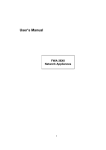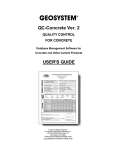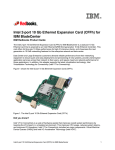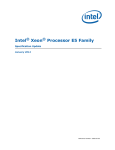Download Supermicro AOC-STG-I2T
Transcript
AOC-STG-i2T
User's Guide
Revision 1.0
The information in this User's Guide has been carefully reviewed and is believed to be accurate.
The vendor assumes no responsibility for any inaccuracies that may be contained in this document,
and makes no commitment to update or to keep current the information in this user's guide, or to
notify any person or organization of the updates. Please Note: For the most up-to-date version
of this user's guide, please see our Website at www.supermicro.com.
Super Micro Computer, Inc. ("Supermicro") reserves the right to make changes to the product
described in this user's guide at any time and without notice. This product, including software and
documentation, is the property of Supermicro and/or its licensors, and is supplied only under a
license. Any use or reproduction of this product is not allowed, except as expressly permitted by
the terms of said license.
IN NO EVENT WILL SUPER MICRO COMPUTER, INC. BE LIABLE FOR DIRECT, INDIRECT,
SPECIAL, INCIDENTAL, SPECULATIVE OR CONSEQUENTIAL DAMAGES ARISING FROM THE
USE OR INABILITY TO USE THIS PRODUCT OR DOCUMENTATION, EVEN IF ADVISED OF
THE POSSIBILITY OF SUCH DAMAGES. IN PARTICULAR, SUPER MICRO COMPUTER, INC.
SHALL NOT HAVE LIABILITY FOR ANY HARDWARE, SOFTWARE, OR DATA STORED OR USED
WITH THE PRODUCT, INCLUDING THE COSTS OF REPAIRING, REPLACING, INTEGRATING,
INSTALLING OR RECOVERING SUCH HARDWARE, SOFTWARE, OR DATA.
Any disputes arising between the manufacturer and the customer shall be governed by the laws of
Santa Clara County in the State of California, USA. The State of California, County of Santa Clara
shall be the exclusive venue for the resolution of any such disputes. Supermicro's total liability for
all claims will not exceed the price paid for the hardware product.
FCC Statement: This equipment has been tested and found to comply with the limits for a Class
A digital device pursuant to Part 15 of the FCC Rules. These limits are designed to provide
reasonable protection against harmful interference when the equipment is operated in a commercial
environment. This equipment generates, uses, and can radiate radio frequency energy and, if not
installed and used in accordance with the manufacturer’s instruction manual, may cause harmful
interference with radio communications. Operation of this equipment in a residential area is likely
to cause harmful interference, in which case you will be required to correct the interference at your
own expense.
California Best Management Practices Regulations for Perchlorate Materials: This Perchlorate
warning applies only to products containing CR (Manganese Dioxide) Lithium coin cells. “Perchlorate
Material-special handling may apply. See www.dtsc.ca.gov/hazardouswaste/perchlorate”.
WARNING: Handling of lead solder materials used in this
product may expose you to lead, a chemical known to
the State of California to cause birth defects and other
reproductive harm.
User's Guide Revision 1.0
Release Date: March 6, 2012
Unless you request and receive written permission from Super Micro Computer, Inc., you may not
copy any part of this document.
Information in this document is subject to change without notice. Other products and companies
referred to herein are trademarks or registered trademarks of their respective companies or mark
holders.
Copyright © 2012 by Super Micro Computer, Inc.
All rights reserved.
Printed in the United States of America
Preface
Preface
About this User's Guide
This user's guide is written for system integrators, PC technicians and
knowledgeable PC users. It provides information for the installation and use of the
AOC-STG-i2T add-on card.
About this Add-on Card
The Supermicro AOC-STG-i2T is the most energy-efficient and cost-effective
10GbE adapter solution for data centers in today's market. The AOC-STG-i2T offers
auto-negotiation between 1GbE and 10GbE, supporting backward compatibility for
smooth transition from 1GbE to 10GbE. It addresses the demands of bandwidthintensive applications at a fraction of the cost of a traditional 10GbE adapter by
utilizing RJ-45 connections for a longer cabling distance. The Supermicro AOCSTG-i2T 10GbE adapter is truly a best-in-class solution for advanced data centers.
This add-on card is intended to be used with Supermicro's servers or motherboards
as an integrated solution package. For more information regarding product support
or updates, please refer to our website at http://www.supermicro.com/products/nfo/
networking.cfm#adapter.
An Important Note to the User
All images and layouts shown in this user's guide are based upon the latest PCB
Revision available at the time of publishing. The card you have received may or
may not look exactly the same as the graphics shown in this user's guide.
Returning Merchandise for Service
A receipt or copy of your invoice marked with the date of purchase is required before
any warranty service will be rendered. You can obtain service by calling your vendor for a Returned Merchandise Authorization (RMA) number. When returning the
motherboard to the manufacturer, the RMA number should be prominently displayed
on the outside of the shipping carton, and the shipping package is mailed prepaid
or hand-carried. Shipping and handling charges will be applied for all orders that
must be mailed when service is complete. For faster service, You can also request
a RMA authorization online (http://www.supermicro.com).
iii
AOC-STG-i2T Add-on Card User's Guide
This warranty only covers normal consumer use and does not cover damages incurred in shipping or from failure due to the alternation, misuse, abuse or improper
maintenance of products.
During the warranty period, contact your distributor first for any product problems.
Conventions Used in the User's Guide
Pay special attention to the following symbols for proper system installation and to
prevent damage to the system or injury to yourself:
Warning: Important information given to ensure proper system installation
or to prevent damage to the components or injury to yourself.
Note: Additional information given to differentiate between various models
or provides information for correct system setup.
iv
Preface
Contacting Supermicro
Headquarters
Address:
Super Micro Computer, Inc.
980 Rock Ave.
San Jose, CA 95131 U.S.A.
Tel:
+1 (408) 503-8000
Fax:
+1 (408) 503-8008
Email:
[email protected] (General Information)
[email protected] (Technical Support)
Website:
www.supermicro.com
Europe
Address:
Super Micro Computer B.V.
Het Sterrenbeeld 28, 5215 ML
's-Hertogenbosch, The Netherlands
Tel:
+31 (0) 73-6400390
Fax:
+31 (0) 73-6416525
Email:
[email protected] (General Information)
[email protected] (Technical Support)
[email protected] (Customer Support)
Asia-Pacific
Address:
Super Micro Computer, Inc.
4F, No. 232-1, Liancheng Rd.
Chung-Ho 235, Taipei County
Taiwan, R.O.C.
Tel:
+886-(2) 8226-3990
Fax:
+886-(2) 8226-3991
Website:
www.supermicro.com.tw
Email:
[email protected] (Technical Support)
Tel: +886-(2) 8226-5990 (Technical Support)
v
AOC-STG-i2T Add-on Card User's Guide
Table of Contents
Preface
Chapter 1 Overview
1-1 Overview.......................................................................................................... 1-1
1-2 Product Highlights............................................................................................ 1-1
1-3 Technical Specifications................................................................................... 1-1
1-4 Compliance/Operating Environment................................................................ 1-4
Chapter 2 Hardware Components
2-1 Add-On Card Image and Layout...................................................................... 2-1
2-2 Major Components........................................................................................... 2-1
2-3 Connectors: LAN Ports and LAN LED Indicators............................................ 2-2
Ethernet Ports............................................................................................. 2-2
GLAN Port LEDs......................................................................................... 2-2
2-4 Jumpers: 3.3V Standby ....................................................................................... Power Jumper.................................................................................................. 2-3
Explanation of Jumpers................................................................................... 2-3
3.3V Standby Power Enable....................................................................... 2-3
Chapter 3 Installation
3-1 Static-Sensitive Devices................................................................................... 3-1
Precautions...................................................................................................... 3-1
Unpacking........................................................................................................ 3-1
3-2 Before Installation............................................................................................ 3-2
3-3 Installing the Add-on Card............................................................................... 3-2
3-4 Installing the Windows Operating System....................................................... 3-3
3-5 Installing the Linux Operating System............................................................. 3-3
Build a Binary RPM Package.......................................................................... 3-3
3-6 Building the Driver Manually............................................................................ 3-4
vi
Chapter 1: Overview
Chapter 1
Overview
1-1 Overview
Congratulations on purchasing your add-on card from an acknowledged leader in
the industry. Supermicro products are designed with the utmost attention to detail
to provide you with the highest standards in quality and performance. For product
support and updates, please refer to our website at http://www.supermicro.com/
products/nfo/networking.cfm#adapter.
1-2 Product Highlights
The product highlights of this add-on card include the following:
•Dual RJ45 Connectors
•Low-Profile, Short Length Standard Form Factor
•PCI Express 2.1 (2.5GT/s or 5GT/s)
•Intel® QuickData Technology
•VMDq, Next-Generation VMDq, and PC-SIG SR-IOV for Virtualized Environ
ments
•Jumbo Frame Support up to 15.5KB
•Load Balancing on Multiple CPUs
•iSCSI Remote Boot Support
1-3 Technical Specifications
General
•Intel® X540 10GbE controller with integrated 10GBase-T copper PHYs
•Compact size low-profile standard form factor
1-1
AOC-STG-i2T Add-on Card User's Guide
•PCI-E x8 2.1 (2.5GT/s or 5GT/s) interface
•Dual RJ-45 connectors with speed up to 10Gb/port
•Load balancing on multiple CPUs
•Intel® PROSet Utility for Windows® Device Manager
•Maximum power consumption: about 13W
I/O Features
•Intel® QuickData Technology: DMA engine that enhances data acceleration and
lowers CPU usage
•Support for jumbo frames of up to 15.5KB
•802.1q VLAN support
•Two
integrated independent 10GBase-T interfaces operate at 10GBase-T
(10Gb/s) and 1000Base-T (1Gb/s) modes
•Direct Cache Access (DCA) to avoid cache misses
•MSI-X support to minimize interrupt overhead and to allow load-balancing between multiple cores/CPUs
•Receives and Transmits Side Scaling for Windows environment and Scalable
I/O for Linux environments
Performance
•TCP/UDP Segmentation Offload
•IPv6 Support for IP/TCP and IP/UDP Receive Checksum Offload
•Supports Fibre Channel over Ethernet (FCoE)
•Low latency interrupts
•DCA support
1-2
Chapter 1: Overview
Virtualization
•Support for Virtual Machine Device Queues (VMDq and Next-generation VMDq)
•L2 Ethernet MAC address and VLAN filters
•PC-SIG SR-IOV implementation
•Advanced Packet Filtering
•VLAN support to allow creation of multiple VLAN segments
Manageability
•Preboot eXecution Environment (PXE) support
•Simple Network Management Protocol (SNMP) and Remote Network Monitoring
(RMON) statistics counters
•iSCSI remote boot
Required Cables
•RJ-45 Category-6 up to 55m; Category-6A up to 100m.
OS Support
The AOC-STG-i2T add-on card supports the following operating systems (OS):
•Windows® Vista SP2, 2003 SP2, 2008 SP2
•Linux: RedHat EL, SuSe SLES
•FreeBSD
Dimensions
The AOC-STG-i2T add-on card supports both full-height and low-profile brackets.
The dimensions of the card is listed below:
•5.4 in. (13.7 cm) x 2.5 in (6.35 cm) (L x H)
1-3
AOC-STG-i2T Add-on Card User's Guide
Platform Support
The following platforms are supported by the AOC-STG-i2T add-on card:
•Motherboards with minimum PCI-E x8 slot support
•Server systems with low-profile or full-height PCI-E x8 expansion slots
Note: This product is intended to be used with Supermicro server systems
or motherboards as an integrated solution package.
1-4 Compliance/Operating Environment
The AOC-STG-i2T add-on card is compliant with the following environmental regulations:
•RoHS Compliant 6/6, Pb Free
1-4
Chapter 2: Hardware Components
Chapter 2
Hardware Components
2-1 Add-On Card Image and Layout
4
1
2
3
The AOC-STG-i2T Image
4
U216
JLAN1
LAN Port1
2
J2
3V Standby
PWR Enable
1
U201
Intel(R) X540
LAN Chip
JLAN2
LAN Port2
3
FAN1
U202
AOC-STG-i2T Rev. 1.0
The AOC-STG-i2T Layout
2-2 Major Components
The following major components are installed on the AOC-STG-i2T:
1. Intel® X540 10Gb/1Gb LAN Controller
2. (RJ45 Ethernet) LAN Port 1 & LAN1 LED Indicator
3. (RJ45 Ethernet) LAN Port 2 & LAN2 LED Indicator
4. 3.3V Standby Power Enable (Jumper)
2-1
AOC-STG-i2T Add-on Card User's Guide
2-3 Connectors: LAN Ports and LAN LED Indicators
Ethernet Ports
LAN Ports
Pin Definition
Two Ethernet ports (LAN1/LAN2) are
located on the add-on card. These
ports support connection speeds of
10Gbps and 1Gbps. Plug the RJ45
type cables into LAN Port1 and LAN
Port2 to provide Ethernet connections.
Refer to the add-on card layout on
Page 2-1 for the locations of the LAN
ports. Also, see the table on the left for
LAN port pin definitions.
Pin# Definition
1
M_MDI0_P0
2
M_MDI0_N0
3
M_MDI0_P1
9
LINK0_10G
6
M_MDI0_N1
10
LINK0_1G
4
M_MDI0_P2
11
LINK0_LINKUP
5
M_MDI0_N2
12
LINK0_ACT_N
7
M_MDI0_P3
13
GND
8
M_MDI0_N3
14
GND
Activity LED
GLAN Port LEDs
Two LAN ports (LAN 1/LAN 2) are
located on the add-on card. Each
Ethernet LAN port has two LEDs. The
green LED on the left indicates activity;
while the other LED on the right may
be green, amber or Off to indicate the
speeds of the connections. See the
tables at right for more information.
2-2
Link LED
LAN 1/LAN 2 Activity LED (Left)
LED State
Color
Status
Definition
Green
Flashing
Active
LAN 1/LAN 2 Link LED (Right)
LED State
IPMI LAN
Definition
(X8ST3-F)
10 Gbps
LED Color
Green
Amber
1 Gbps
Off
100 Mbps or No Connection
Chapter 2: Hardware Components
2-4 Jumpers: 3.3V Standby Power Jumper
Connector
Pins
Explanation of Jumpers
Jumper
Cap
To modify the operation of the add-on card, a
jumper can be used to choose between optional
settings. A jumper creates shorts between two
pins to change the function of the connector. Pin
1 is identified with a square solder pad on the
printed circuit board. See the add-on card layout
on Page 2-1 for the jumper location.
Setting
3
Note: On two pin jumpers, "Closed"
means the jumper is on and "Open"
means the jumper is off the pins.
3.3V Standby Power Enable
The 3.3V Standby Power Enable jumper is
located at J2 on the add-on card. Refer to the
layout on Page 2-1 for the location of the jumper. Close Pins 1 & 2 to enable 3.3V Standby
Power for Wake-on-LAN support. The default
setting is Disabled.
3
2
2
1
1
Pin 1-2 short
3.3V Standby PWR Enable
Jumper Settings
Jumper setting Definition
1-2
Enabled
(See the note below)
2-3
Disabled (default)
Note: If this jumper is set to "Enabled", LAN chip overheat may occur.
Be sure to provide adequate system cooling when the jumper is enabled.
2-3
AOC-STG-i2T Add-on Card User's Guide
Notes
2-4
Chapter 3: Installation
Chapter 3
Installation
3-1 Static-Sensitive Devices
Electrostatic Discharge (ESD) can damage electronic components. To avoid damaging your add-on card, it is important to handle it very carefully. The following
measures are generally sufficient to protect your equipment from ESD.
Precautions
•Use a grounded wrist strap designed to prevent static discharge.
•Touch a grounded metal object before removing the add-on card from the
antistatic bag.
•Handle the add-on card by its edges only; do not touch its components, or
peripheral chips.
•Put the add-on card back into the antistatic bags when not in use.
•For grounding purposes, make sure that your system chassis provides excellent
conductivity between the power supply, the case, the mounting fasteners and
the add-on card.
Unpacking
The add-on card is shipped in antistatic packaging to avoid static damage. When
unpacking your component or your system, make sure that the person handling it
is static protected.
Note: To avoid damaging your components and to ensure proper installation, be sure to always connect the power cord last, and always remove it
before adding, removing or changing any hardware components.
3-1
AOC-STG-i2T Add-on Card User's Guide
3-2 Before Installation
To install the add-on card properly, be sure to follow the instructions below.
1. Power down the system.
2. Remove the power cord from the wall socket.
3. Use industry standard anti-static equipment (such as gloves or wrist strap)
and follow the instructions listed on Page 3-1 to avoid damage caused by
ESD.
4. Familiarize yourself with the server, motherboard, and/or chassis documentation.
5. Confirm that your operating system includes the latest updates and hotfixes.
3-3 Installing the Add-on Card
Follow the steps below to install the add-on card into your system.
1. Remove the server cover and, if necessary, set aside any screws for later
use.
2. Remove the add-on card slot cover. If the case requires a screw, place the
screw aside for later use.
3. Position the add-on card in the slot directly over the connector, and gently
push down on both sides of the card until it slides into the PCI connector.
4. Secure the add-on card to the chassis. If required, use the screw that you
previously removed.
5. Attach any necessary external cables to the add-on card.
6. Replace the chassis cover.
7. Plug the power cord into the wall socket, and power up the system.
3-2
Chapter 3: Installation
3-4 Installing the Windows Operating System
Follow the steps below to install the drivers needed for your Windows OS support.
The controller comes with a driver on the CD-ROM CDR-NIC.
1. Run the CDR-NIC. (If you do not have a product CD-ROM, download drivers
from the Supermicro Support Website and then transfer them to your system.)
2. When the SUPERMICRO window appears, click on the computer icon next to
the product model.
Note: If the FOUND NEW HARDWARE WIZARD screen displays on your
system, click CANCEL.
3. Click on INSTALL DRIVERS AND SOFTWARE.
4. Follow the prompts to complete the installation.
3-5 Installing the Linux Operating System
Follow the steps below to install the driver to a Linux system.
Build a Binary RPM Package
1. Run ‘rpmbuild -tb <filename.tar.gz>’
2. Replace <filename.tar.gz> with the specific filename of the driver.
Note: For the build to work properly, the current running kernel MUST
match the version and configuration of the installed kernel sources. If you
have just recompiled the kernel, reboot the system at this time.
3-3
AOC-STG-i2T Add-on Card User's Guide
3-6 Building the Driver Manually
Follow the instructions below to build the driver manually.
1. Move the base driver tar file to the directory of your choice. For example, /home/username/ixgbe
or
/usr/local/src/ixgbe.
2. Untar/unzip archive:
tar zxf ixgbe-x.x.x.tar.gz
3. Change to the driver src directory:
cd ixgbe-x.x.x/src/
4. Compile the driver module:
make install
The binary will be installed as:
/lib/modules/[KERNEL_VERSION]/kernel/drivers/net/ixgbe/ixgbe.[k]o
The install locations listed above are the default locations. They might not be
correct for certain Linux distributions. For more information, see the ldistrib.txt
file included in the driver tar.
Note: IXGBE_NO_LRO is a compile time flag. The user can enable it at
compile time to remove support for LRO from the driver. The flag is used
by adding CFLAGS_EXTRA=-”DIXGBE_NO_LRO” to the make file when
it’s being compiled.
make CFLAGS_EXTRA=”-DIXGBE_NO_LRO” install
5. Load the module:
For kernel 2.6.x, use the modprobe command:
modprobe ixgbe <parameter>=<value>
For 2.6 kernels, the insmod command can be used if the full path to the driver
module is specified. For example:
insmod /lib/modules/<KERNEL VERSION>/kernel/drivers/net/ixgbe/ixgbe.ko
3-4
Chapter 3: Installation
In addition, when using 2.6-based kernels, make sure that older ixgbe drivers
are removed from the kernel before loading the new module. To do this, use:
rmmod ixgbe; modprobe ixgbe
6. Assign an IP address to the interface by entering the following, where x is the
interface number:
ifconfig ethx <IP_address> netmask <netmask>
7. Verify that the interface works. Enter the following, where <IP_address> is the
IP address for another machine on the same subnet as the interface that is
being tested:
ping <IP_address>
3-5
AOC-STG-i2T Add-on Card User's Guide
Notes
3-6
(Disclaimer Continued)
The products sold by Supermicro are not intended for and will not be used in life support systems, medical equipment, nuclear facilities or systems, aircraft, aircraft devices,
aircraft/emergency communication devices or other critical systems whose failure to perform be reasonably expected to result in significant injury or loss of life or catastrophic
property damage. Accordingly, Supermicro disclaims any and all liability, and should buyer use or sell such products for use in such ultra-hazardous applications, it does so
entirely at its own risk. Furthermore, buyer agrees to fully indemnify, defend and hold Supermicro harmless for and against any and all claims, demands, actions, litigation, and
proceedings of any kind arising out of or related to such ultra-hazardous use or sale.



































